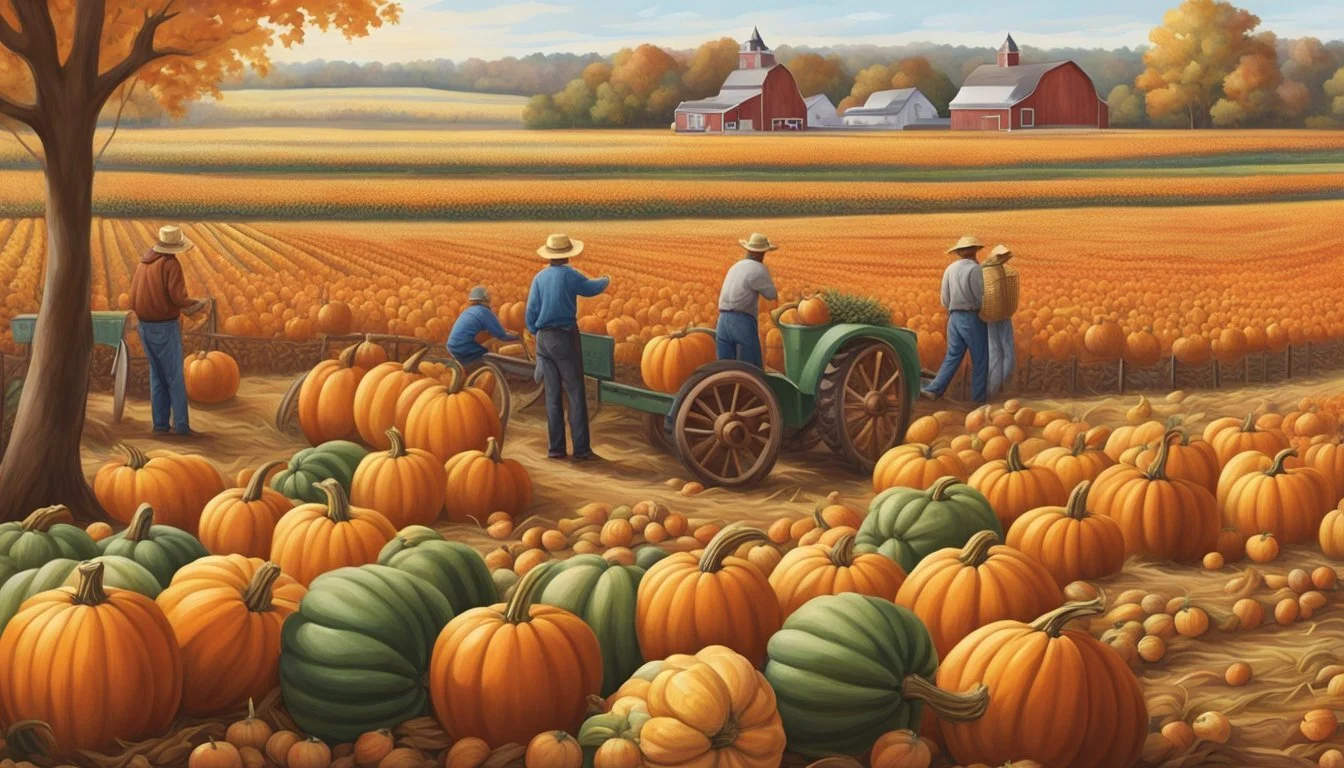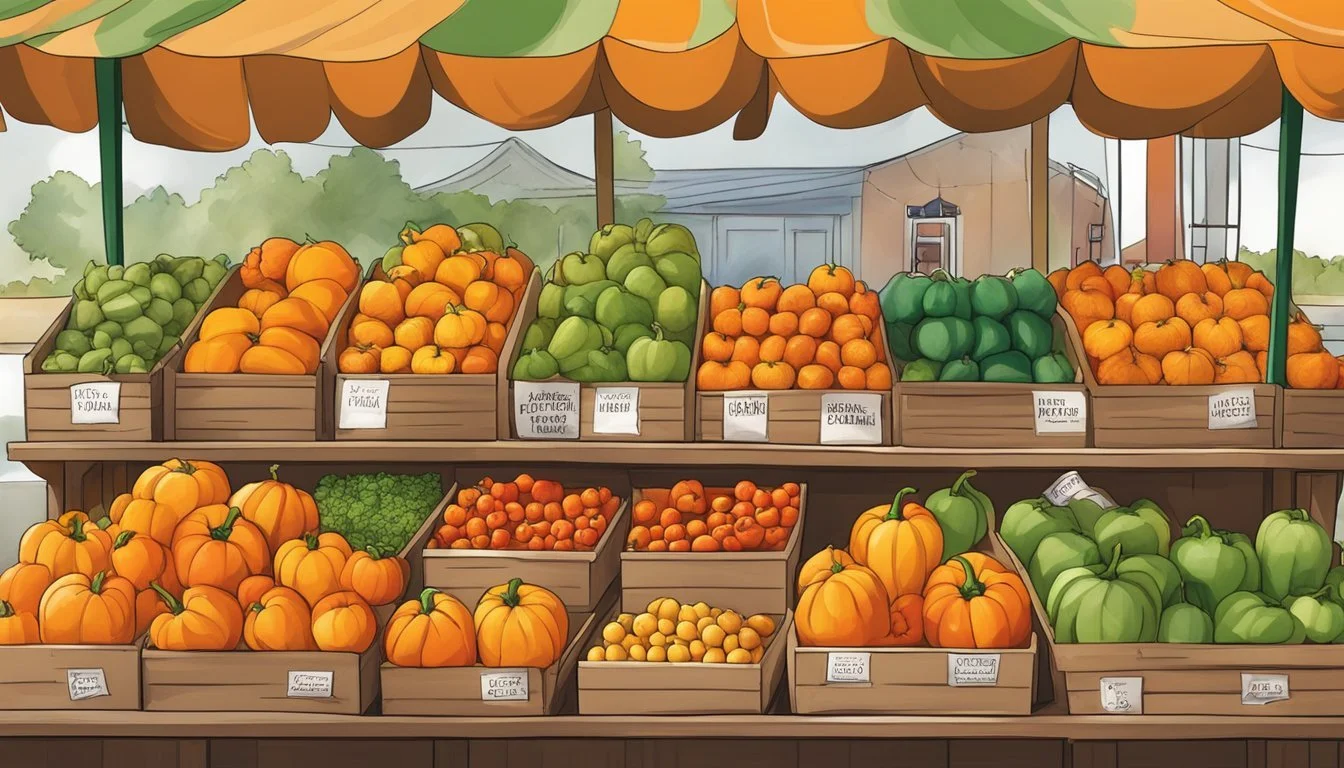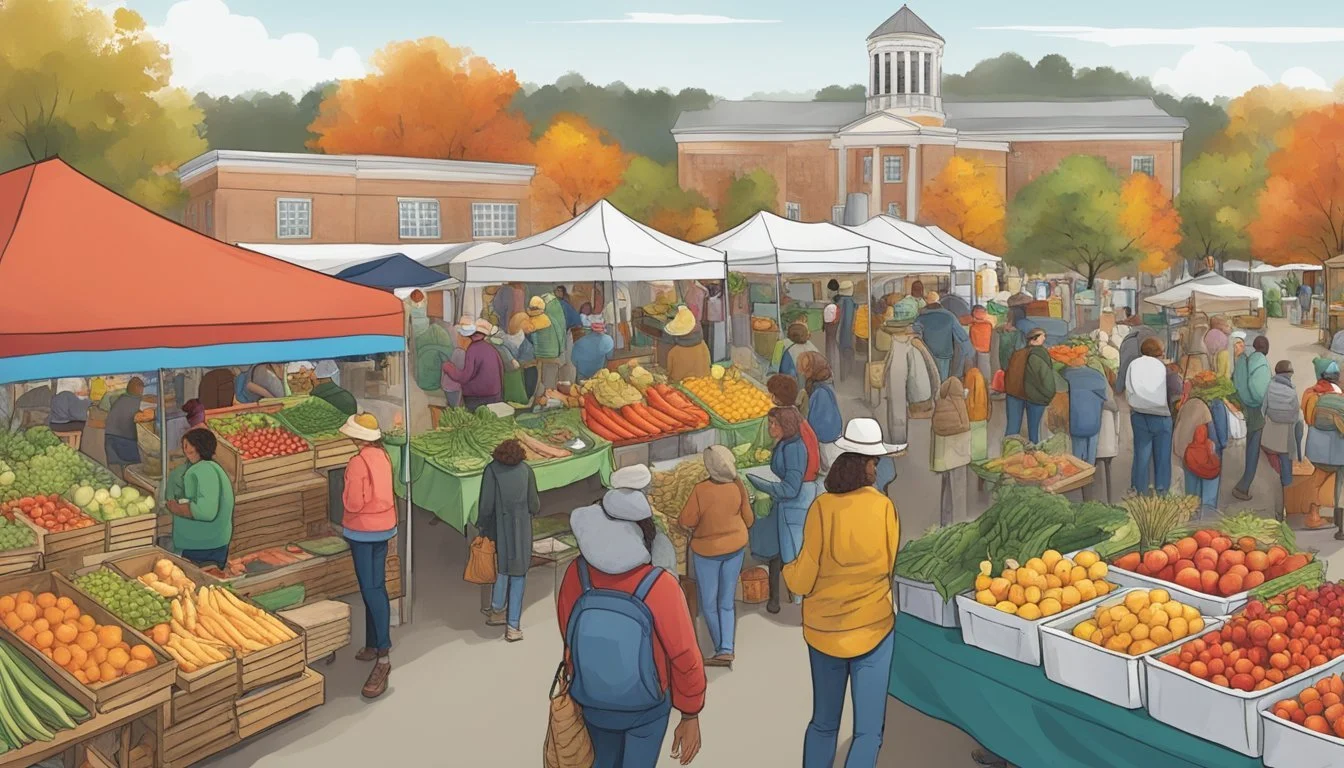Alabama Seasonal Fruit & Vegetables in November
A Guide to Fresh Produce
This Article is Part of our Alabama Seasonal Fruit & Veg Calendar
November in Alabama brings a shift in the growing season as the state experiences cooler temperatures. While the range of produce available may narrow, the fruits and vegetables that can be harvested during this time are notable for their rich flavors and nutritional value. Gardeners and consumers alike can look forward to a variety of seasonal offerings that are well-suited to the autumn climate.
During this month, root vegetables thrive in the cooler soils of Alabama. Carrots, turnips, and radishes are among the hardy vegetables that can be found fresh in November. These root vegetables not only add a colorful variety to dishes but also contribute an array of vitamins and minerals to the diet. Greens such as collards, kale, and mustard (how long does mustard last?), which are resistant to the decreasing temperatures, remain abundant and lend themselves well to hearty soups and stews synonymous with fall cuisine.
Fruit selections in November are narrower compared to the summer months, yet citrus fruits begin to make their appearance, marking the start of their season. Alabama's citrus, while more limited in variety than warmer states like Florida, still offers fresh options such as satsumas and kumquats. With the approach of the winter holidays, these fruits become a valuable addition to the state's seasonal produce repertoire, providing a burst of fresh flavor and vitamin C.
Understanding Seasonal Eating in Alabama
Seasonal eating in Alabama revolves around the understanding of what produce is available during various months of the year. November is a key transition month, where the state enjoys the last yields of fall and prepares for the winter.
Fall in Alabama brings a bountiful harvest, and residents can enjoy a variety of fresh vegetables and fruits that are in their peak season. The focus on fresh produce not only supports local agriculture but also ensures higher nutritional content and better flavor.
Here's a snapshot of what to expect in November:
Vegetables Fruits Sweet Potatoes (What wine goes well with sweet potatoes?) Apples (how long do apples last?) Pumpkins Pears Turnips Collard Greens (how long do collard greens last?)Mustard Greens Winter Squash
Eating with the seasons has its benefits, such as enjoying produce that hasn't been shipped from far, thus reducing one's carbon footprint. Moreover, seasonal eating often comes with the chance to savor heirloom and specialty varieties that are not available year-round.
Alabama's fall season, particularly November, is a prime time for consumers to explore local farmers' markets. Here they'll find not only fresh produce but also the chance to connect with the source of their food—learning about the food's journey from the farm to their plate.
Alabama's Seasonal Fruits in November
In November, Alabama’s fruit harvest includes a range of flavors from the tart crispness of apples to the unique sweetness of persimmons. Varied citrus fruits begin to peak, while pears continue to grace market shelves.
Apples
Alabama's apple varieties are still available in November. They include a range of flavors and textures—suitable for baking or fresh eating. Local markets and orchards offer these fruits, which have been harvested in the earlier fall months.
Persimmons
The persimmon, with its rich, honey-like flavor, is a celebrated fruit in November. They thrive in Alabama's climate, ripening to a soft, sweet pulp. Persimmons are typically ready for consumption when they are soft to the touch.
Citrus Fruits
November marks the beginning of the citrus season in Alabama. Satsumas, a type of mandarin, are among the first citrus fruits to ripen. Their juicy segments are both sweet and tangy, offering a refreshing snack or a bright addition to recipes.
Pears
Pears remain in season throughout November, providing a mellow, sweet taste and grainy texture. Varieties common in Alabama, such as the Bartlett, can be found in farmers markets and stores, perfect for both cooking and fresh consumption.
Alabama's Seasonal Vegetables in November
In November, Alabama's farms offer an abundance of seasonal vegetables, including the hearty sweet potatoes, a variety of nutrient-rich greens, versatile winter squash, and an array of robust root vegetables.
Sweet Potatoes
Sweet potatoes in Alabama are at their peak in November. This starchy, sweet-tasting root vegetable is versatile in the kitchen, whether baked, roasted, or mashed. They are a staple for many Thanksgiving tables and are known for their high vitamin A content.
Greens
An assortment of greens thrives in Alabama's cooler November weather. Kale, mustard greens, and turnip greens are especially tender and flavorful during this month. These greens are typically rich in vitamins and minerals and can be used in salads, soups, and side dishes.
Winter Squash
Types of winter squash such as butternut, acorn, and hubbard are plentiful in November. These squash varieties offer a sweet, nutty flavor and can be roasted, pureed into soups, or used as a healthy addition to pies. They are also filled with fiber and important nutrients like beta-carotene.
Root Vegetables
Root vegetables, including carrots, radishes, and rutabaga, are among the most suitable choices for harvesting in November. These vegetables are known for their long shelf life and can be a great source of complex carbohydrates and essential vitamins. Rutabaga, in particular, often overlooked, can add a distinctive taste to winter dishes.
Recipes and Preparation Ideas
November in Alabama brings a palette of flavors to the table, rich in both nutrition and fiber. The following recipes and preparation ideas make the most of seasonal produce through vibrant salads, hearty main dishes, luscious desserts, and preservation techniques.
Salads and Sides
The natural sweetness and earthy flavors of Alabama's seasonal produce can elevate salads and side dishes. One can create a Pomegranate Kale Salad by tossing chopped kale with pomegranate seeds (how long do pomegranate seeds last?), walnuts, and a light vinaigrette, providing a dish high in fiber and bold in taste. Additionally, Roasted Acorn Squash with a sprinkle of cinnamon and a drizzle of honey can serve as a warm, nutritious side that complements any main course.
Main Dishes
Seasonal vegetables can be the cornerstone of satisfying main courses. For example, a Butternut Squash (how long does butternut squash last?) and Turkey Chili is not only comforting but also packed with nutrition, incorporating lean ground turkey and cubes of butternut squash simmered in a tomato-based sauce with traditional chili spices. Vegetarians might opt for a Delicata Squash Stuffed with Quinoa and Kale, offering a complete protein and a variety of flavors in one dish.
Desserts
Desserts crafted from November's produce can be both delightful and health-conscious. A classic Baked Pear with Honey and Walnuts serves as a simple yet elegant dessert, where the natural juiciness of the pears is enhanced by the caramelization from baking. Additionally, an Apple and Cranberry Crisp harnesses the tartness of cranberries balanced with the sweetness of apples, topped with a crispy oat crust for added texture and fiber.
Preserving the Harvest
Preserving the bounty of November ensures that the flavors can be enjoyed long after the season ends. Cranberry Chutney, made with fresh cranberries, orange zest, and spices, can be canned and saved for future meals. Another method is freezing; for example, dicing and freezing Sweet Peppers allows one to retain their flavor and nutritional value for use in recipes year-round.
Health Benefits of Seasonal Produce
Eating seasonal produce, such as the fruits and vegetables available in Alabama during November, offers several health advantages. They are typically richer in vitamins and minerals due to being harvested at peak ripeness. For instance, vegetables like sweet potatoes are an excellent source of vitamin A, which is crucial for eye health, while greens like kale provide vitamin K, essential for bone health.
Fiber content tends to be higher in fresh, seasonal produce. This is not only beneficial for digestive health but also helps in maintaining a feeling of fullness, which can contribute to weight management. Seasonal fruits like apples and pears are great examples, offering a combination of fiber and essential nutrients.
Furthermore, the nutritional quality of produce can decline with time and distance traveled from farm to plate. Seasonal produce is usually consumed closer to the time and place of harvest, ensuring a more nutritious profile. Here's a breakdown of key elements found in seasonal produce available during November in Alabama:
Produce Vitamins Minerals Fiber Sweet Potatoes Vitamin A Potassium High Turnip Greens Vitamin C, K Calcium High Apples Vitamin C --- Moderate Pears Vitamin C Copper, Iron High Pecans --- Magnesium Moderate
In summary, incorporating seasonal fruits and vegetables into one's diet can be a powerful way to boost immunity, support bodily functions, and increase overall health through enhanced nutrient intake.
Growing Your Own Seasonal Produce
With November's cooler temperatures in Alabama, gardening efforts shift focus towards cultivating cool-season crops and herbs. The gardener's attention is centered on proper plant care and preparation for harvest.
Gardening Tips
In November, Alabama gardeners focus on maintaining soil health and protecting plants from any early frosts. They often incorporate mulch to insulate root systems and ensure that garden beds retain moisture. A selection of herbs like parsley, sage, and thyme are robust options, as they continue to thrive in cooler weather.
Soil Preparation: Amend soil with compost and organic matter to provide nutrients for the growing plants.
Watering Schedule: Reduce watering frequency, but ensure plants receive deep watering to encourage strong root development.
Protection: Use cloches or row covers to shield plants from cold snaps.
Harvesting Suggestions
For Alabama gardeners, November marks the harvest season for many cool-weather crops, while late fall plantings set the stage for early spring harvests. They can expect to gather mature produce from their garden, carefully timing the harvest to optimize flavor and longevity.
Root Vegetables: Such as turnips and beets, should be harvested before the ground freezes.
Leafy Greens: Kale, collards, and spinach can be picked when the leaves reach a desirable size.
Herbs: Harvest perennial herbs sparingly to prevent new growth that could be damaged by freezing temperatures.
By applying these targeted techniques, gardeners can enjoy a bountiful November harvest and prepare their garden for continued success in the following season.
Local Agricultural Practices
In November, Alabama's farmers focus on harvesting crops suitable for the fall season. Each county adheres to agricultural practices that ensure the optimal yield and quality of produce. The state of Alabama's climate, consisting of warm days and cool nights, contributes to the growth of a variety of fruits and vegetables during this period.
Farmers employ crop rotation and strategic planting schedules to maximize the fertility of the soil and prevent pest infestations. Irrigation practices are tailored to the needs of each crop, especially given November's typically lower rainfall.
Government regulations in Alabama ensure that agricultural practices meet safety and environmental standards. Commodity commissions and local extension offices provide farmers with guidance on sustainable practices and compliance with state laws.
The harvest season is a critical time, so farmers utilize machinery and manual labor to efficiently gather crops. Here's a list of typically harvested produce in Alabama during November:
Vegetables: Beets, Cabbages (green, napa, red, savoy), Cauliflower, Radishes
Fruits: Apples (late varieties), Pecans
The table below summarizes the relevant produce and their respective counties known for cultivation:
Produce County Known For Cultivation Beets Baldwin County Cabbages Cullman County Cauliflower Blount County Radishes Madison County Apples (late) Shelby County Pecans Mobile County
Alabama's farmers remain committed to producing high-quality, seasonal produce by following well-established local agricultural practices. They continually adapt to the changing weather patterns to secure a successful November harvest.
Where to Find Seasonal Produce
In Alabama, November brings a diverse array of fresh produce to the table. Consumers seeking the freshest fruits and vegetables can explore various local resources.
Farmers Markets
Farmers markets throughout the state are bustling hubs for seasonal goods. They allow consumers to purchase directly from growers, ensuring peak freshness and support for local agriculture. Jefferson County, for example, hosts markets where one can find everything from crisp collard greens to sweet, ripe apples. Markets usually operate on set days throughout the week, providing ample opportunity for shoppers to stock up on fresh offerings.
Grocery Stores
Grocery stores in Alabama might source produce from both local farms and national distributors. While the selection of local produce can vary, stores strive to label goods to indicate their origin, allowing customers to choose the freshest local options. Shopping at grocery stores also affords customers the convenience of finding a wide selection of produce in one place.
Community Supported Agriculture (CSA)
CSAs are a means for customers to buy seasonal produce directly from farmers through a subscription-based model. Participants receive a share of the harvest, typically on a weekly basis, which can include a variety of fruits and vegetables harvested within their county or region. This model ensures that members get the freshest seasonal produce while also investing in their local farming community.
Storing and Extending Freshness
Preserving the integrity of fresh fruits and vegetables during November in Alabama involves understanding the nuances of storage conditions. Different crops have specific needs for temperature, humidity, and circulation.
For root vegetables like turnips and beets, a cool, dark place such as a cellar is ideal, maintaining their freshness longer. Refrigeration can extend their life, but they should be stored in crisper drawers away from fruits to prevent them from absorbing ethylene gas, which could hasten spoilage.
Green vegetables such as cabbages and green beans should also be refrigerated. It's advisable to wrap them loosely in damp paper towels and store in perforated plastic bags to retain moisture. This method can prolong their crispness and vibrancy for several days.
Refrigeration Best Practices:
Root Vegetables: Place in crisper, away from fruit.
Leafy Greens: Wrap in damp towels, use perforated bags.
When planning to store vegetables for an extended period, one might consider freezing as an option. However, most vegetables, like green beans and peppers, should be blanched first to preserve color, flavor, and nutritional value before freezing. Once blanched, they should be cooled, dried, and placed in air-tight containers or freezer bags.
Freezing Guidelines:
Blanching: Crucial for most veggies prior to freezing.
Storage: Use air-tight containers or freezer bags.
By implementing these storage techniques, one ensures the longevity and quality of Alabama's seasonal produce, helping it remain as fresh and nutritious as possible until use.
Engaging with Local Food Communities
Alabama's local food communities thrive through year-round interactions, especially in November when local produce is abundant. These communities flourish online and at various culinary events.
Social Media and Online Communities
Social media platforms like Facebook and Twitter provide vibrant spaces for locals to connect over Alabama's seasonal produce. Facebook groups dedicated to Alabama farming and gardening allow members to share tips, recipes, and updates on what's fresh and available. Twitter enables quick communication between consumers and food producers, with chefs often chiming in with expert advice on how to best use seasonal fruits and vegetables.
Local Culinary Events
Alabama's culinary events bring together food enthusiasts, chefs, and producers to celebrate the season's harvest. These events typically feature tastings, cooking demonstrations, and markets where chefs showcase dishes using November's bounty like sweet potatoes, greens, and a variety of squashes. Attendance at such events offers a direct line to the region’s freshest ingredients and the stories of the people who grow and cook them.










